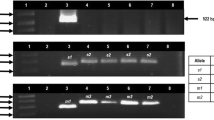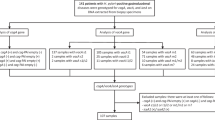Abstract
Peptic ulcer disease incidence is decreasing. Both s1m1 and s1m2 vacA gene combinations of Helicobacter pylori have been associated with the development of major gastroduodenal diseases. This study assessed whether H. pylori vacA gene arrangement changed over 15 years in a Southern Italy area. H. pylori-positive patients observed in January–June 1989 and January–June 2005 were selected. Histological specimens were retrieved to extract DNA for vacA arrangement characterization (mid-m and peptide signal-s regions) by using the polymerase chain reaction. Fifty-nine patients in the first period and 56 matched patients in the second period were evaluated. A correlation between s1 presence and intestinal metaplasia at histology was found. Overall, the s1m1 combination increased (P < 0.01) and s2m2 decreased (P < 0.001) during the study period. In detail, s1m1 (P < 0.05) and s1m2 (P < 0.01) increased, and s2m2 decreased (P < 0.001) in dyspeptic patients, while only s1m1 increased (P < 0.01) in peptic ulcer patients. Finally, few cases of s2m1 combination in both series were found. Our results show some unexpected aspects that require confirmation. In detail, the increased prevalence of potential more virulent H. pylori strains contrasts with peptic ulcer incidence reduction.
Similar content being viewed by others
References
Atherton JC, Cao P, Peek RM Jr et al (1995) Mosaicism in vacuolating cytotoxin alleles of Helicobacter pylori. Association of specific vacA types with cytotoxin production and peptic ulceration. J Biol Chem 270:17771–17777. doi:10.1074/jbc.270.30.17771
Molnar B, Szoke D, Ruzsovics A et al (2008) Significantly elevated Helicobacter pylori density and different genotype distribution in erosions as compared with normal gastric biopsy specimen detected by quantitative real-time PCR. Eur J Gastroenterol Hepatol 20:305–313
Ogiwara H, Graham DY, Yamaoka Y (2004) The Helicobacter pylori restriction endonuclease-replacing gene, hrgA, and clinical outcome: comparison of East Asia and Western countries. Dig Dis Sci. 49:1551–1555. doi:10.1023/B:DDAS.0000042263.18541.ec
Cellini L, Grande R, Di Campli E et al (2006) Analysis of genetic variability, antimicrobial susceptibility and virulence markers in Helicobacter pylori identified in Central Italy. Scand J Gastroenterol 41:280–287. doi:10.1080/00365520510024223
Han SR, Schreiber HJ, Bhakdi S et al (1998) vacA genotypes and genetic diversity in clinical isolates of Helicobacter pylori. Clin Diagn Lab Immunol 5:139–145
van Doorn LJ, Figueiredo C, Sanna R et al (1998) Clinical relevance of the cagA, vacA, and iceA status of Helicobacter pylori. Gastroenterology 115:58–96. doi:10.1016/S0016-5085(98)70365-8
Morales-Espinosa R, Castillo-Rojas G, Gonzalez-Valencia G et al (1999) Colonization of Mexican patients by multiple Helicobacter pylori strains with different vacA and cagA genotypes. J Clin Microbiol 37:3001–3004
Letley DP, Lastovica A, Louw JA et al (1999) Allelic diversity of the Helicobacter pylori vacuolating cytotoxin gene in South Africa: rarity of the vacA s1 a genotype and natural occurrence of an s2/m1 allele. J Clin Microbiol 37:1203–1205
Kauser F, Hussain MA, Ahmed I et al (2005) Comparative genomics of Helicobacter pylori isolates recovered from ulcer disease patients in England. BMC Microbiol 5:32–35. doi:10.1186/1471-2180-5-32
Yakoob J, Fan XG, Hu GL et al (2001) Polycolonization of Helicobacter pylori among Chinese subjects. Clin Microbiol Infect 7:187–192. doi:10.1046/j.1198-743x.2001.00226.x
Scholte GH, van Doorn LJ, Quint WG et al (2001) Genotyping of Helicobacter pylori strains in formalin-fixed or formaldehyde-sublimate-fixed paraffin-embedded gastric biopsy specimens. Diagn Mol Pathol 10:166–170. doi:10.1097/00019606-200109000-00004
Sicinschi LA, Correa P, Peek RM Jr et al (2008) Helicobacter pylori genotyping and sequencing using paraffin-embedded biopsies from residents of colombian areas with contrasting gastric cancer risks. Helicobacter 13:135–145. doi:10.1111/j.1523-5378.2008.00554.x
Scholte GH, van Doorn LJ, Cats A et al (2002) Genotyping of Helicobacter pylori in paraffin-embedded gastric biopsy specimens: relation to histological parameters and effects on therapy. Am J Gastroenterol 97:1687–1695. doi:10.1111/j.1572-0241.2002.05775.x
Perez-Perez GI, Salomaa A, Kosunen TU et al (2002) Evidence that cagA(+) Helicobacter pylori strains are disappearing more rapidly than cagA(−) strains. Gut 50:295–298. doi:10.1136/gut.50.3.295
Argent RH, Thomas RJ, Aviles-Jimenez F et al (2008) Toxigenic Helicobacter pylori infection precedes gastric hypochlorhydria in cancer relatives, and H. pylori virulence evolves in these families. Clin Cancer Res 14:2227–2235. doi:10.1158/1078-0432.CCR-07-2022
Rudi J, Kolb C, Maiwald M et al (1998) Diversity of Helicobacter pylori vacA and cagA genes and relationship to VacA and CagA protein expression, cytotoxin production, and associated diseases. J Clin Microbiol 36:944–948
van Doorn LJ, Glupczynski Y, Kusters JG et al (2001) Accurate prediction of macrolide resistance in Helicobacter pylori by a PCR line probe assay for detection of mutations in the 23S rRNA gene: multicenter validation study. Antimicrob Agents Chemother 45:1500–1504. doi:10.1128/AAC.45.5.1500-1504.2001
Dixon MF, Genta RM, Yardley JH et al (1996) Classification and grading of gastritis. The updated Sydney System. Am J Surg Pathol 20:1161–1181. doi:10.1097/00000478-199610000-00001
Rugge M, Correa P, Dixon MF et al (2002) Gastric mucosal atrophy: interobserver consistency using new criteria for classification and grading. Aliment Pharmacol Ther 16:1249–1259. doi:10.1046/j.1365-2036.2002.01301.x
Yeomans ND, Naesdal J (2008) Systematic review: ulcer definition in NSAID ulcer prevention trials. Aliment Pharmacol Ther 27:465–472
Talley NJ, Stanghellini V, Heading RC et al (1999) Functional gastroduodenal disorders. Gut 45(Suppl 2):1137–1142
Soltermann A, Perren A, Schmid S et al (2005) Assessment of Helicobacter pylori clarithromycin resistance mutations in archival gastric biopsy samples. Swiss Med Wkly 135:327–332
De Francesco V, Margiotta M, Zullo A et al (2006) Primary clarithromycin resistance in Italy assessed on Helicobacter pylori DNA sequences by TaqMan real time polymerase chain reaction. Aliment Pharmacol Ther 23:429–435. doi:10.1111/j.1365-2036.2006.02769.x
Koehler A, Kunz-Schughart LA, Hofstaedter F et al (2007) Multiple molecular analyses from minimal cell quantities by sequential isolation and preamplification of DNA and RNA. Diagn Mol Pathol 6:141–146. doi:10.1097/PDM.0b013e318050aace
Kidd M, Lastovica AJ, Atherton JC et al (1999) Heterogeneity in the Helicobacter pylori vacA and cagA genes: association with gastroduodenal disease in South Africa? Gut 45:499–492
Moayyedi P, Malfertheiner P (2002) Helicobacter pylori and non-malignant disease. Helicobacter 7(Suppl 1):30–6. doi:10.1046/j.1523-5378.7.s1.5.x
Matysiak-Budnik T, Laszewicz W, Lamarque D et al (2006) Helicobacter pylori and non-malignant diseases. Helicobacter 11(Suppl 1):27–31. doi:10.1111/j.1478-405X.2006.00426.x
Nervi G, Liatopoulou S, Cavallaro LG et al (2006) Does Helicobacter pylori infection eradication modify peptic ulcer prevalence? A 10 years endoscopical survey. World J Gastroenterol 12:2398–2401
Maconi G, Tosetti C, Miroglio G et al (1999) Management of Helicobacter pylori-related gastrointestinal diseases by general practitioners in Italy Aliment. Pharmacol Ther 13:1499–1504
Malfertheiner P, Megraud F, O’Morain C et al (2007) Current concepts in the management of Helicobacter pylori infection—the Maastricht III Consensus Report. Gut 56:772–781. doi:10.1136/gut.2006.101634
Sharma VK, Howden CW (2004) A national survey of primary care physicians’ perceptions and practices related to Helicobacter pylori infection. J Clin Gastroenterol 38:326–331. doi:10.1097/00004836-200404000-00006
Russo P, Brutti C (2007) Proton pump inhibitors and hospital discharge rates for gastrointestinal events in Italy: a national ecological study. Clin Ther 29:751–758. doi:10.1016/j.clinthera.2007.04.008
Panayotopoulou EG, Sgouras DN, Papadakos K et al (2007) Strategy to characterize the number and type of repeating EPIYA phosphorylation motifs in the carboxyl terminus of CagA protein in Helicobacter pylori clinical isolates. J Clin Microbiol 45:488–495. doi:10.1128/JCM.01616-06
Higashi H, Yokoyama K, Fujii Y et al (2005) EPIYA motif is a membrane-targeting signal of Helicobacter pylori virulence factor CagA in mammalian cells. J Biol Chem 280(24):23130–23137. doi:10.1074/jbc.M503583200
Martínez A, González C, Kawaguchi F et al (2001) Helicobacter pylori: cagA analysis and vacA genotyping in Chile. Detection of a s2/m1 strain. Rev Med Chil 129:1147–1153
Author information
Authors and Affiliations
Corresponding author
Rights and permissions
About this article
Cite this article
De Francesco, V., Margiotta, M., Zullo, A. et al. Helicobacter pylori vacA Arrangement and Related Diseases: A Retrospective Study Over a Period of 15 Years. Dig Dis Sci 54, 97–102 (2009). https://doi.org/10.1007/s10620-008-0327-6
Received:
Accepted:
Published:
Issue Date:
DOI: https://doi.org/10.1007/s10620-008-0327-6




